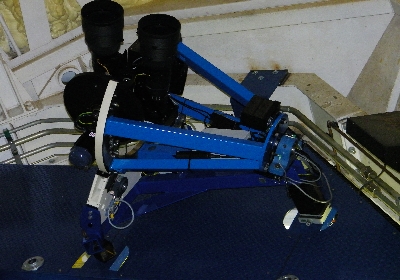
Assassin Picture of the Week
 | APOW Assassin Picture of the Week |
|
|
Brutus is EXPANDING!
|
ASAS-SN is currently shut down as
our survey doubles in size. In the foreground of the left image above,
you can see how Brutus has been for the past year, with two cameras on
a common mount. On the right, you can see that Brutus now has twice as
many cameras. These additions will allows us to survey more of the sky
at a faster cadence. Brutus will now help us to find more SNe and to
find them earlier! The new system is expected to be back on sky for
the first time tonight, and we hope to be back discovering some of the
most interesting transients objects in the sky within a week. Brutus is hosted by the Las Cumbres Observatory Global Telescope Network (LCOGT) in the "clam shell" enclosure of the Faulkes Telescope North 2m (background of the left picture) at the Haleakala Observatory in Hawaii. To achieve large field of view with a very stable and uniform point-spread-function (PSF) across the field, we use Nikon AF-S NIKKOR 400mm f/2.8G ED VR AF lenses. We had high expectations for these lenses and were not disappointed: we obtain very stable and sharp images for many nights in a row. Since we are using relatively small telescopes (lenses), we cannnot afford to waste many photons. As our detectors we have selected ProLine PL230 CCD cameras from FLI, with back-iluminated E2V sensors, giving us high QE, low-noise and fast readout (and of course they are electrically cooled). To cover >10,000 thousand square degrees each night, we take many hundreds of images nightly, and we have been very happy with the reliability of our cameras. A special thanks to Mark Elphick and David Mullins for working hard to make this transition quickly! |
Back to ASAS-SN page.
See previous APOWs:
Swift Ultraviolet and Optical Follow-Up of ASASSN-13dl, Our Latest Supernova
Dramatic AGN Outburst in NGC 2617
Two ASAS-SN Views of Orion Nebula
AAVSO Observations of Cataclysmic Variable ASASSN-13ck
Two ASAS-SN Supernovae in One Day!
Extreme M-dwarf Flare Observed by ASAS-SN;
Multiband photometric follow-up of ASASSN-13aw (SN 2013dr);
How ASAS-SN Discovers Supernovae: Case of Supernova ASASSN-13bb;
NGC 2617: Dramatic Seyfert Type Change;
ASASSN-13/SN 2013da: Our First Supernova Three Weeks Later;
This homepage is maintained by Ben Shappee, Tom Holoien and Kris Stanek.
Updated Sun Oct 6 17:13:57 EDT 2013